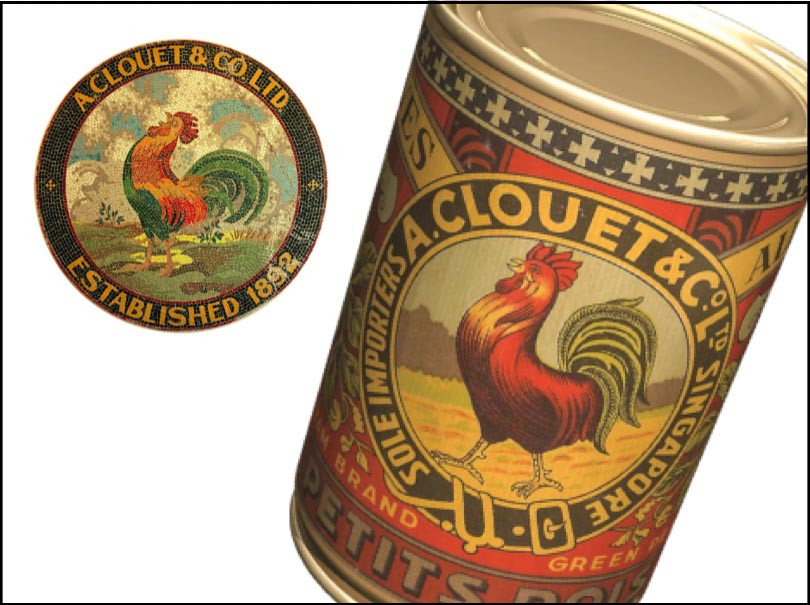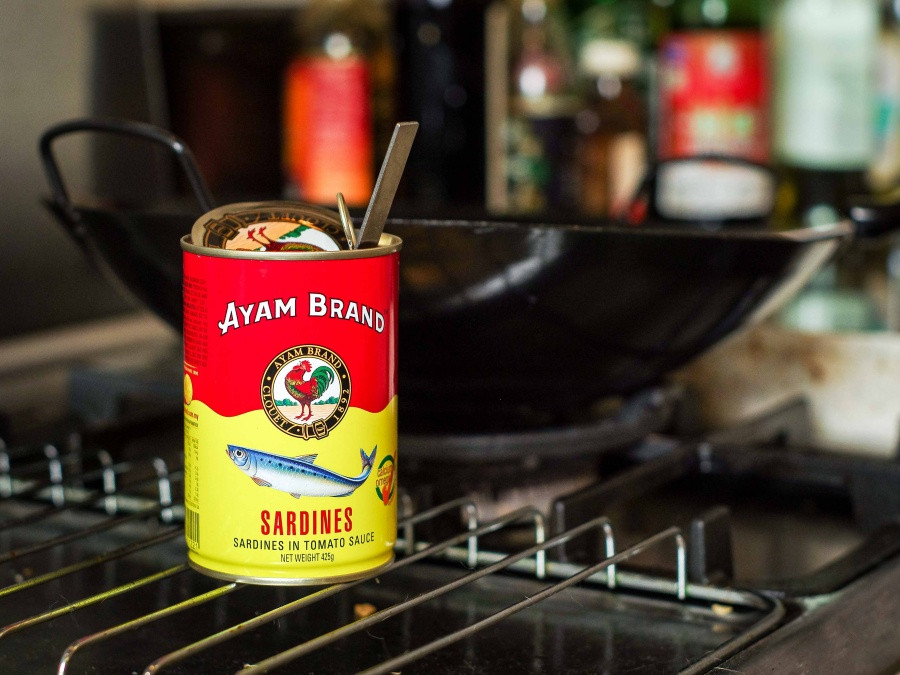How did tinned sardines become a staple in Malaysian kitchens?
by Ceri Holloway18 Jun 2021
The tin of Ayam Brand sitting in your pantry has a long history—from its French colonial roots to its former status symbol for aristocrats.
There are few food items as versatile yet unassuming as the iconic Ayam Brand sardines in tomato sauce. Seen on the dusty shelves of kedai runcit as well as in the brightly lit aisles of large department stores, these tightly packed punches of protein find their ways into the baskets and trolleys of many grocery shoppers. They are taken home for a rainy day to have with rice, for spreading in picnic sandwiches, or for bulking up mee goreng. Whether spiced up in a wok or simply heated up in a microwave, tinned sardines have become a humble constant of Malaysian home cooking.
The early days of tinned sardines
In a 2019 New Straits Times article, Alan Teh highlighted the French origins of Ayam Brand sardines. Alfred Clouet, a French colonist in Malaya, switched from importing French goods to focusing on canned and preserved foods. Upon seeing the seasonal abundance of fresh sardines in Malayan wet markets, he sought to make them a year-round commodity and began canning them in 1899.
Tinned foods were at first seen as symbols of colonialism and high social status, given that the tins themselves were difficult and expensive to produce. As seen in recent writings about the presence of tinned sardines in other Asian countries, they were initially begrudgingly consumed by colonists who were unwilling to fully embrace the local cuisines of the regions they settled in. Thi Nguyen writing on the French colonists in Vietnam and Elaine Castillo writing on the American imperialists in the Philippines both cite how the expatriate population viewed native Southeast Asian food as unsanitary and therefore inedible.
This desire to further cement the divide between colonisers and colonised peoples, however, was soon deconstructed. The local Southeast Asian population eventually took to tinned foods and appropriated them for their own use, as evident from the assimilation of tinned sardines into the Malaysian diet.
How tinned sardines evolved
With the increase of Malaysian manufacturing in the years leading up to World War II, canning prices dropped and tinned sardines became a staple grocery item for even the middle and lower social classes. This growth in popularity is supported by a 1926 report, which showed that 18.5% of all exported California sardines went to Malaya alone.
Other research from the time shows women who bought tinned sardines saw them as an easy source of protein for their families, and they were a good ‘backup’ to have when they had run out of fresh meat or fish to cook at home. Aside from convenience, it was noted that families genuinely liked the taste of the tinned sardines as home cooks could easily add more familiar local flavours, such as chillies. Cecilia Leong-Salobir’s book Urban Food Culture highlights how tinned sardines trickled down to even the most marginalised in Malayan society, with Changi prison camp internees eating a tablespoon of the fish with the small amount of plain rice they were given for lunch.
By the 1970s and 1980s, sardine sandwiches were a common appearance in Home and Domestic Science textbooks, according to Dr. Khoo Gaik Cheng’s recollection of her own school days. That sardine sandwiches were thus ‘sandwiched’ between more familiar local recipes like bihun goreng and ondeh-ondeh, and it shows how the once-foreign tinned sardines had been absorbed into Malaysian cooking. Several friends’ parents who I spoke to in the process of writing this piece have also mentioned other ways they have eaten tinned sardines, including as an assam laksa condiment and stir-fried with onions.
Linda Ooi, founder of the food website Roti n Rice, highlights how sardine and cucumber sandwiches were a must-have at school parties. As our Malaysian diet is rice- and noodle-heavy, the cute triangular sandwiches would have been a welcome treat on special occasions, alongside other ‘Western’ foods like nuggets and cocktail sausages.
How tinned sardines are eaten today
Now, when I go home in the summer holidays to Malaysia, I see my family’s pantry stocked with the essentials: several flavours of Maggi noodles, a collection of packet soups, and a stack of Ayam Brand tinned sardines. My mother has been making her sardine dish for as long as I can remember. Her recipe is simple, and it became one of the very first dishes I learnt how to cook once I was tall enough to see over our stovetop. First, she fries shallots and some garlic until they are fragrant. Then, she empties the tin (or tins) of sardines and adds a little tomato puree. Right at the end when everything is warmed through, a couple of beaten eggs are stirred in until the tomato sauce is thickened. My mum makes this in our big wok and serves it in the ever-recognisable blue and white faux porcelain bowl.
Many renditions of this dish can be found in households across Malaysia, most commonly with the added kick of cili padi or combining it with curry. Mrs Cheong, a home cook and working mother, notes how she grew up eating tinned sardines in a similar way, mainly with onions and tomato sauce.
Pointing out its colonial origins, I asked her why—in her opinion—these sardines became so popular in Malaysia. “We never saw tinned sardines as a foreign import or considered them as ‘Western’ food,” she replied, “they’ve always been around and have been a staple food for as long as I can remember.” She added, “Tinned sardines were constantly available in convenience stores and supermarkets, so this availability and their affordability probably made them very appealing to Malaysian families.”
Based on several Malaysian recipe sites such as Fried Chillies, another home favourite is—perhaps unsurprisingly—nasi goreng sardin: fried rice being a trademark method of food assimilation throughout Southeast Asia. Besides this, sardines can also be found adapted to other local classics like asam pedas and roti john. Although tinned sardines were born out of a Frenchman’s business opportunism, Malaysian cooks have found infinite ways to reinscribe their ownership, making it an emblem of home cooking: simple, bold, and delicious.
Try our recipe for home-style sardine sambal.
***
Born and bred in Malaysia, Ceri Holloway is currently at university in the UK. She often cooks Malaysian classics for her non-Malaysian house of seven.
Read next
How a Japanese technique influenced Malaysian bakeries
The era of soft buns

The value of tapioca through the eras
Tapioca, past and present

The making of budu, our underrated condiment
A spotlight on budu







